Dominican Major Leaguers and the Provinces They Hail From
It shouldn’t come as any great surprise to a typical baseball fan that Dominican players play an outsized role in Major League Baseball today. In fact, the Dominican Republic, which has a population roughly just 3.3% that of the United States, supplies MLB with upwards of 10% of its players. Major League Baseball and baseball fans are better off because of this. After all, who wants to live in a baseball world without Nelson Cruz or Fernando Tatis Jr., for instance?
With this point in mind, the following takes a look at players from the Dominican Republic. More specifically, where in the D.R. players were born and when they made their way to MLB. What follows will be split into three brief sections: a description of the data utilized, some insights into the growth of the D.R.’s influence in MLB, and finally some map-based depictions of the players’ provinces of birth within the Dominican Republic.
I: The Data
Data for this piece comes from two places: the player data (WAR, years active, date of birth, location of birth) was pulled from Baseball-Reference and the population/province data was pulled from Wikipedia (not exactly academic, I know).
Baseball-Reference features the option to group players by nationality. At the time that this Dominican player dataset was pulled (7/29/2021), there were 813 players listed as being born in the D.R. who had then gone on to play in MLB. After exporting data from the Dominican Republic’s B-R page, there was some light data wrangling to do.
First, the positional history of each player had to be made to classify each player as either primarily a pitcher or a hitter (no Shohei Ohtani classification dilemmas here). Next, birthplace data had to be broken up into two fields for provinces and cities, respectively. As a last step, each player was assigned a decade which they would be sorted into based on when they played. This was done by taking the average of each player’s debut season and final season and rounding that average to the nearest tens place (e.g. a player who played from 2008 to 2013 would be assigned the 2010 decade).
The city data was a little messy or incomplete at Baseball-Reference, but province data appears to have all been there. Of the 32 provinces in the Dominican Republic, those 813 eventual MLB players had been born in all but three.
II: Trends and Insights
Before addressing the “where,” let’s address some of the “when.” Because data for player positions and primary decade of play were taken, data was first grouped by those fields. This view immediately challenged one particular preconception I personally had regarding Dominican players: that there have been more Dominican-born hitters than pitchers, which is in fact incorrect.
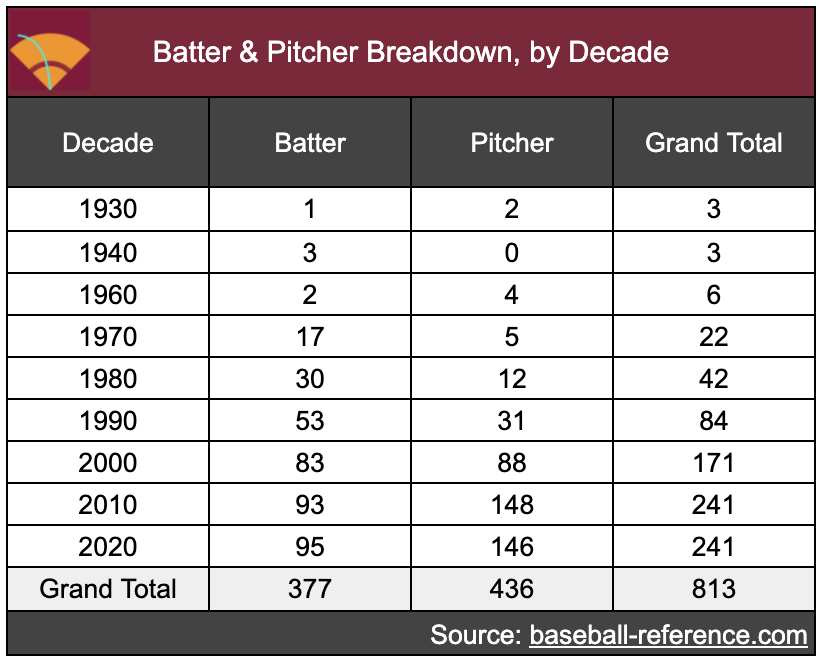
The Dominican presence in MLB looks to have really taken off around the 1990s. And indeed, until around that point most of the Dominican big leaguers were in fact position players, as opposed to pitchers. Pitchers, in sheer total of players at least, have eclipsed hitters in the 21st century.
The number of Dominican players continues to rise, too. Both the 2010 and 2020 decades feature 241 players, but it is only 2021; there is plenty of time for this next generation of players to make their impact on the game.
Baseball-Reference also kindly includes player WAR (bWAR) in its original dataset. Given this, I pulled the average bWAR per player type and decade, which is given in the table below.
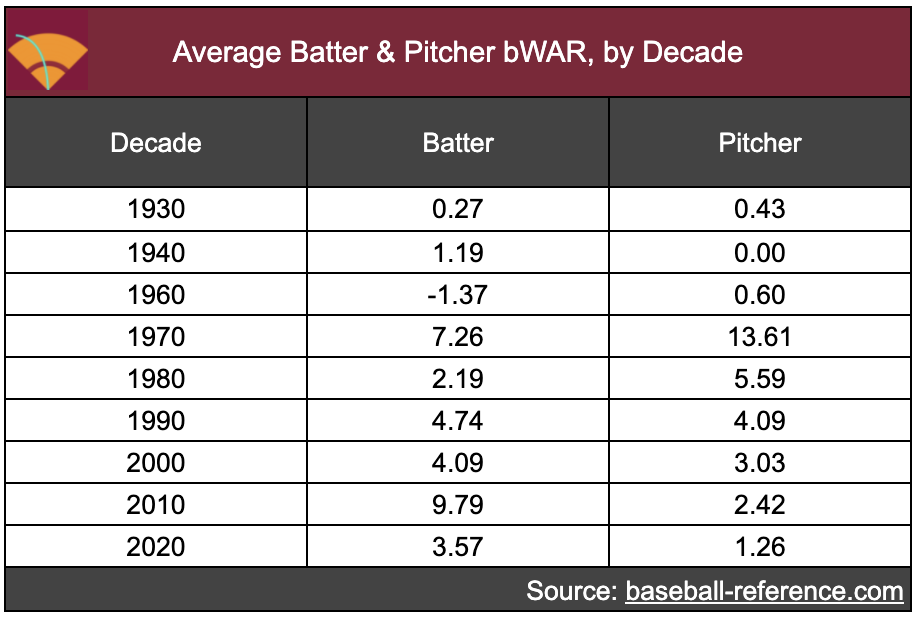
This second chart begins to elucidate the seemingly hitter-heavy presence of Dominican players: on average they have been more productive, though there have been fewer in number over the last few decades. In fact, the top-10 list of players in bWAR, which you can access on the same BR page by sorting for bWAR, includes just two pitchers: Juan Marichal and Pedro Martínez.
However, perhaps the most eye-opening point from the chart above is the average bWAR for hitters whose careers were primarily around 2010: those players were worth nearly 10 bWAR on average. That group was boosted by all-time greats like Albert Pujols, David Ortiz, and Adrián Beltré, but as a whole they were nonetheless incredibly impressive.
Next, a look at the highest bWAR player from each province in the Dominican Republic.
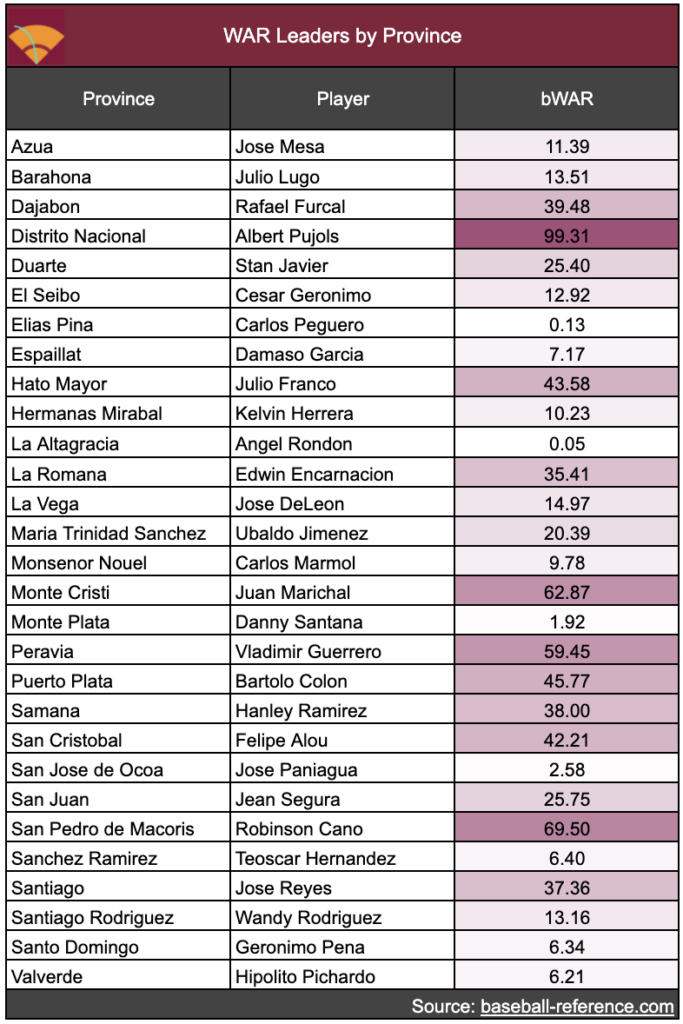
This is an interesting breakdown if only to illustrate the considerable variance across provinces in the Dominican Republic. Rafael Furcal, for instance, represents one of the most successful major league players, yet the Dajabon province has produced just four big leaguers. Another peculiar finding is that the Santo Domingo province, which represents a huge percentage of the D.R.’s population (and also happens to surround the Distrito Nacional), has produced relatively very little in the way of MLB players.
To better contextualize things, this final chart offers a WAR-to-population ratio, or “WAR per MLB player capita” of sorts, with population data coming from Wikipedia.
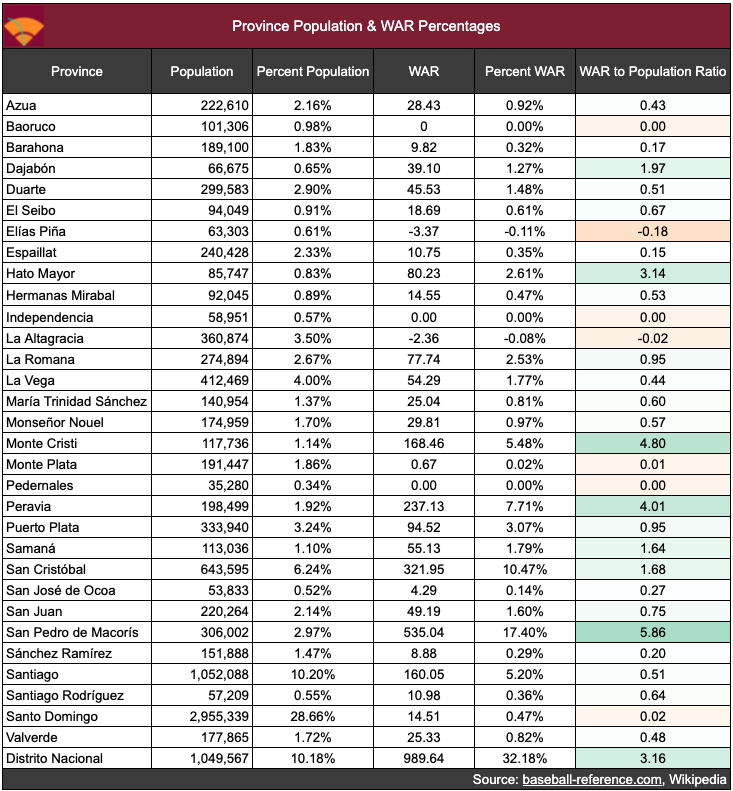
III: Maps
This third section features three maps, created in Tableau, which feature the following: number of MLB players by province, cumulative bWAR by province, and average player bWAR by province. These charts are rather self-explanatory, so I will spare you much commentary aside from brief captions.
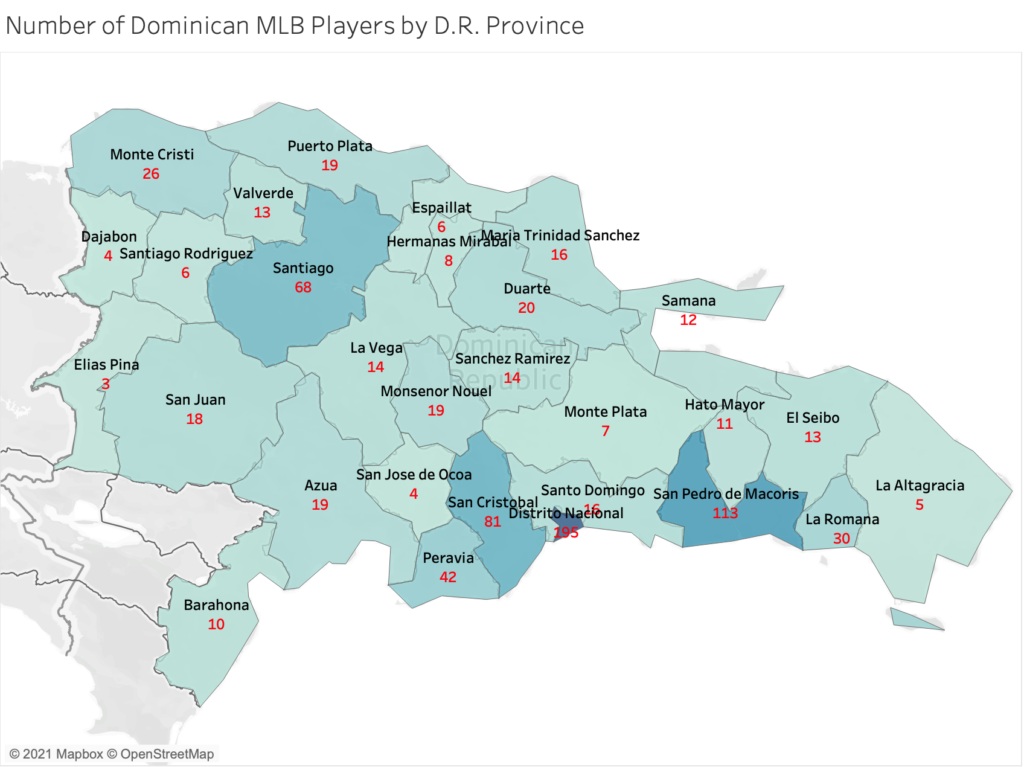
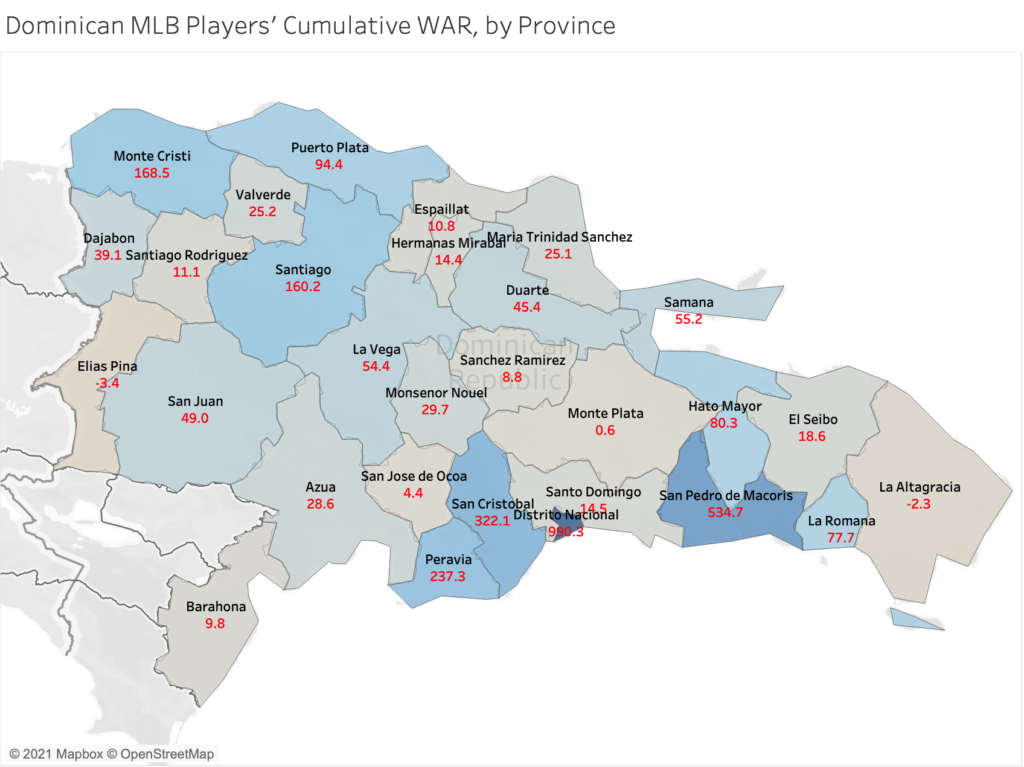
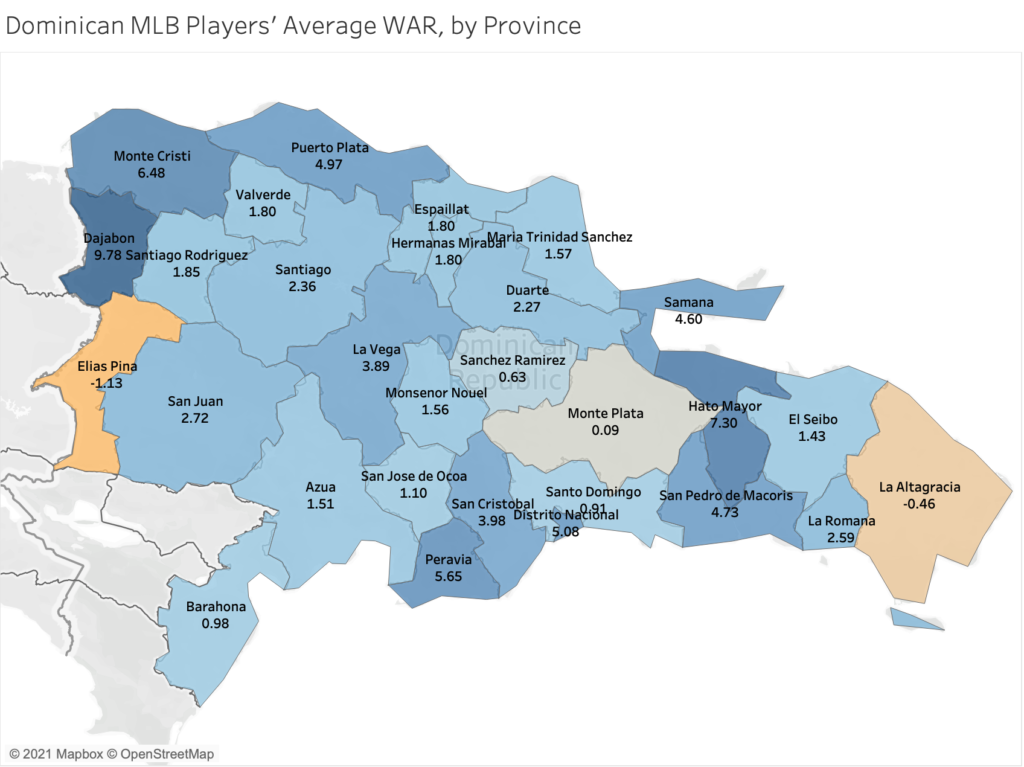
The presence of Dominican players has been on the rise in recent decades and there is no evidence to suggest that trend is changing anytime soon. There are a plethora of implications to this phenomenon, both for the players themselves as well as MLB, none of which are covered here. As one potential avenue for more insight (provided by someone far and away better equipped to provide it) into these matters, I would recommend Dominican Baseball by Alan Klein. Still, I hope this research offers some insights and points of interest.
This piece was originally published on my personal blog.

Great Piece of Work! Love to learn more about the DR in the future!
Thank you so much for reading!
Great!
Just some notes to clarify. As you said, Santo Domingo surrounds Distrito Nacional and is the newest province created in 2001. Santo Domingo metro area is almost compounded by both demarcations and when someone refers to Santo Domingo maybe is talking about Distrito Nacional. Also, many people from Santo Domingo go to Distrito Nacional to receive some service, like giving birth to a child. So, due to convenience and lack of history it’s hard to differienciate between those provinces.
Nelson Cruz was born in Monte Cristi and not in San Cristóbal. You have right the WAR value with 42.21, but that is the WAR for Felipe Alóu, who is the leader for San Cristóbal born players.
The leader from San José de Ocoa is José Paniagua with 2.58, instead of Hansel Robles, who was born in Monseñor Nouel. San José de Ocoa is the other province with recent creation. Paniagua’s assignment is done retroactively like many others players whose current province wasn’t created at the time of their birth, like Julio Franco.
For Elías Piña, the leader is Carlos Peguero. José Sosa is native of Santo Domingo. La Altagracia has a new leader counting from this season with Jesús Sánchez (0.65).
Hello! Thank you for the clarification regarding the Santo Domingo metro area as well as the notes on my errors, I really appreciate these comments. I have updated these player names on my blog as well as reached out to FanGraphs to see if I can get the chart above updated. The one point I haven’t adjusted though relates to Jesús Sánchez, who I haven’t listed as I figure all the data should be consistent as of mid-July.
I have swapped the updated table in. Thank you both for the edits 🙂